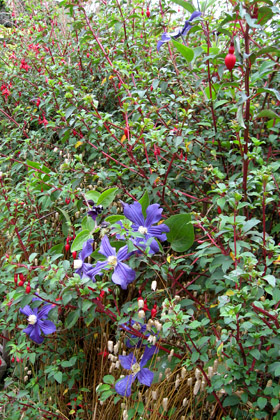Inside The New York Botanical Garden
gardening tips
Posted in Gardening Tips on November 9 2009, by Sonia Uyterhoeven
 |
Sonia Uyterhoeven is Gardener for Public Education. Join her each weekend through November 15 for home gardening demonstrations on a variety of topics in the Home Gardening Center. |
 With all of the crazy weather we’ve had this year, there has been a great deal of discussion of how weather and climate affects the plants we grow and cherish. This reminds me of the importance of microclimates in the garden and how it allows us to often successfully push the vegetative envelope.
With all of the crazy weather we’ve had this year, there has been a great deal of discussion of how weather and climate affects the plants we grow and cherish. This reminds me of the importance of microclimates in the garden and how it allows us to often successfully push the vegetative envelope.
Recently a woman came to a Home Gardening Demonstration that I was giving on herbs and herbal vinegars. We were looking at a collection of healthy rosemary I was growing in containers, a beautiful, blue upright cultivar called ‘Tuscan Blue’. We then wandered over to another section of the garden where a less robust specimen was struggling in a mixed border.
Rosemary, I explained, is borderline hardy in the New York area. We generally keep it in the ground over winter (it is a perennial herb) and then come back and check on it in the spring to see how it has fared. Usually, it is in such a sorry state that we end up removing it and replanting it with a specimen that has been protected in our greenhouses.
“Oh!” she exclaimed, “I had rosemary that flourished at my home for 5 or 6 years, and it never required any winter protection.” She then proceeded to explain that her rosemary had been situated in an area of her garden that was bordered by a cement walkway, which absorbed heat and warmed the bed. A few feet away, the white walls of the neighbor’s house reflected a fair amount of light into the border.
She had found a perfect microclimate for successfully overwintering her rosemary and other Mediterranean plants. The area provided shelter from damaging winter winds, good drainage, and just enough additional warmth to escort her rosemary through the chilly winter months.
This story reminded me of a friend’s New Jersey garden. The brick house’s laundry room heat vent opened up onto a section of the garden where he planted cannas (pictured), and he never had to lift them in the autumn. They flourished in their niche.
Read More
Posted in Gardening Tips on September 7 2009, by Sonia Uyterhoeven
 |
Sonia Uyterhoeven is Gardener for Public Education. Join her each weekend for home gardening demonstrations on a variety of topics in the Home Gardening Center. |
 While many types of gardens are put to bed in the fall, with a little planning the vegetable garden can still grow strong. In the Louise Loeb Vegetable Garden in the Home Gardening Center I practice succession planting and generally have three major planting times during the growing season: late March or early April for early spring crops such as peas; after the last frost date of May 15 (for NYC) for warm season crops; and August to September for cool season crops.
While many types of gardens are put to bed in the fall, with a little planning the vegetable garden can still grow strong. In the Louise Loeb Vegetable Garden in the Home Gardening Center I practice succession planting and generally have three major planting times during the growing season: late March or early April for early spring crops such as peas; after the last frost date of May 15 (for NYC) for warm season crops; and August to September for cool season crops.
One of the easiest vegetable crops to grow in the fall is lettuce. In the spring my harvest is plentiful, and I grow enough lettuce to feed the local family of rabbits and myself. Most lettuces start to suffer in the heat of summer and many bolt or perform poorly unless they are grown in part shade. The end of August gives you another opportunity to grow your own greens.
Asian greens such as mizuna (Brassica rapa var. nipposinica), tat soi (Brassica rapa var. rosularis), and mustard greens (Brassica juncea) are a good option for a late harvest. They come up quickly and can be harvested before they reach maturity.
Loose-leaf lettuces (Lactuca sativa) and mesclun mixes also fare well at this time of year. Not only do they offer a fast and easy late harvest, they also provide some beautiful color in the late-season garden. ‘Forellenschluss’ is a loose-leafed heirloom romaine lettuce that has wonderful red speckles on a green background. ‘Red Ridinghood’ is a Boston-type lettuce that withstands light frosts. Its green leaves are dipped with red.
Read More
Posted in Gardening Tips on February 2 2009, by Sonia Uyterhoeven
Garden Economics
 Sonia Uyterhoeven is Gardener for Public Education at The New York Botanical Garden.
Sonia Uyterhoeven is Gardener for Public Education at The New York Botanical Garden.
While many of us are thinking about curtailing our spending in this economic climate and talk of  reduction seems more appropriate than expansion, for the plantaholic this could potentially be a sobering year. Fortunately for gardening enthusiasts, our good friends across the Atlantic always have some good advice to offer.
reduction seems more appropriate than expansion, for the plantaholic this could potentially be a sobering year. Fortunately for gardening enthusiasts, our good friends across the Atlantic always have some good advice to offer.
Last summer I spent some time over at the late Christopher Lloyd’s legendary garden, Great Dixter, in England learning from the garden’s life force, Fergus Garrett. Fergus is a marvelous combination of passionate plantsman, colorful and creative designer, and experienced educator who is able to communicate his vision.
During my visit he imparted many important design lessons that I will share with you in this and future blog posts. The gardens at Great Dixter are full; in fact they are exploding with plants arranged in a glorious display. Fergus is a big proponent of interplanting and underplanting. No space is wasted in this economical vision.
The question of any seasoned gardener who has undoubtedly experimented with cramming as many plants as possible into a limited space only to see the creation collapse is “How do you make it succeed?”
Fergus has a multi-layered approach to design. He creates his borders the same way you and I would put together a jigsaw puzzle. He works in a piecemeal way—starting with a few initial pieces and then building and slowly improving on the scene. In this design process, he is constantly exploring the seasonal dimension of the borders, the shapes involved, and the partnerships and interactions that are forming between the plants.
As an experienced plantsman, one key component in his design process is to understand and work with the space that plants need to thrive, either individually or in groups. In the example pictured here, he ingeniously works purple clematis into a hardy fuchsia (unfortunately, not hardy in New York).
The clematis benefits from the support of the lanky stems of the fuchsia, which allows it to climb through in an unhindered and happy fashion. The large, flat shape of the clematis contrasts beautifully with the small tubular flowers on the fuchsia. The design is completed with the color echo of the purple clematis and the dangling purple petals on the fuchsia, both dramatically offset by the fuchsia’s bright red sepals and stamens.
 As seen in the photo, the plants form what Fergus refers to as a happy union or marriage, where the plants bring out the best in each other and sustain or support each other as they grow. Next week we will explore his practice of layering plants in more detail.
As seen in the photo, the plants form what Fergus refers to as a happy union or marriage, where the plants bring out the best in each other and sustain or support each other as they grow. Next week we will explore his practice of layering plants in more detail.

 With all of the crazy weather we’ve had this year, there has been a great deal of discussion of how weather and climate affects the plants we grow and cherish. This reminds me of the importance of microclimates in the garden and how it allows us to often successfully push the vegetative envelope.
With all of the crazy weather we’ve had this year, there has been a great deal of discussion of how weather and climate affects the plants we grow and cherish. This reminds me of the importance of microclimates in the garden and how it allows us to often successfully push the vegetative envelope.

 reduction seems more appropriate than expansion, for the plantaholic this could potentially be a sobering year. Fortunately for gardening enthusiasts, our good friends across the Atlantic always have some good advice to offer.
reduction seems more appropriate than expansion, for the plantaholic this could potentially be a sobering year. Fortunately for gardening enthusiasts, our good friends across the Atlantic always have some good advice to offer. As seen in the photo, the plants form what Fergus refers to as a happy union or marriage, where the plants bring out the best in each other and sustain or support each other as they grow. Next week we will explore his practice of layering plants in more detail.
As seen in the photo, the plants form what Fergus refers to as a happy union or marriage, where the plants bring out the best in each other and sustain or support each other as they grow. Next week we will explore his practice of layering plants in more detail.